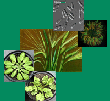| Zhong, WJ; Kaiser, W; Köhler, J; Bauer-Ruckdeschel, H; Komor, E: Phloem loading of inorganic cations and anions by the seedling of ricinus communis l., Journal of Plant Physiology, 152, 328-335 (1998) | |
| Abstract: The increment of the elements K, Na, Mg, Ca, S, P and Cl in hypocotyl and roots during the growth of the Ricinus seedling was compared with the phloem transport of the inorganic ions K+, Na+, M2+, Ca2+, Cl-, SO42- and PO43-. Whereas phloem transport of K+ was twice the rate required for growth of the seedling axis, the Mg2+ and the Cl- translocation were just sufficient and the Cai, sulfate and phosphate translocation rates insufficient. In the latter cases additional transport of organic S- and P-compounds is required.Experimental phloem loading with inorganic ions of endosperm-free cotyledons incubated in various salt solutions had different effects depending on the ions. K+ was loaded up to 80 mM in the phloem sap and not competed by Mg2+ or Na+, but had adverse effects on volume flow at external concentrations above 1 mM. The concentration in phloem sap of Mg2+ (up to 10 mM) and Ca2+ (up to 1 mM) could hardly be increased by incubation in Mg- and Ca-salts, respectively. In general the Ca2+ transport was low. Mg2+ was inhibitory for phloem loading. Na+ loading was larger than Mg2+-loading and was competed by K+.The anions chloride, sulfate and phosphate were loaded into the phloem (Cl- up to 15 mM, sulfate and phosphate up to 20 mM) when given to the incubation medium. Chloride loading competed with sulfate and phosphate, whereas sulfate and phosphate loading did not affect each other or chloride loading.The data are interpreted with respect to the observed ion cycling and ion mobility in plants, especially under saline conditions. From the interaction of phloem loading of the different ions given externally (from the apoplast) together with the background of these ions already present in the cotyledons, it was concluded that Mg2+ and Ca2+ are probably loaded via the symplast, whereas K+, Na+, chloride, sulfate and phosphate are most likely loaded from the apoplast. |

